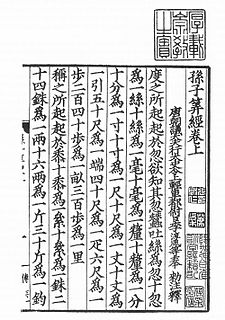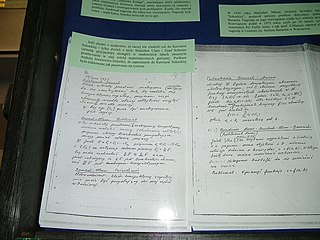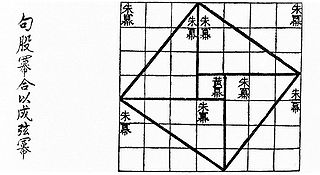 W
WThe Bakhshali manuscript is an ancient Indian mathematical text written on birch bark that was found in 1881 in the village of Bakhshali, Mardan. It is perhaps "the oldest extant manuscript in Indian mathematics." For some portions a carbon-date was proposed of AD 224–383 while for other portions a carbon-date as late as AD 885–993 in a recent study, but the dating has been criticised by specialists on methodological grounds. The manuscript contains the earliest known Indian use of a zero symbol. It is written in Sanskrit with significant influence of local dialects.
 W
WDivina proportione, later also called De divina proportione is a book on mathematics written by Luca Pacioli and illustrated by Leonardo da Vinci, composed around 1498 in Milan and first printed in 1509. Its subject was mathematical proportions and their applications to geometry, to visual art through perspective, and to architecture. The clarity of the written material and Leonardo's excellent diagrams helped the book to achieve an impact beyond mathematical circles, popularizing contemporary geometric concepts and images.
 W
WAlbert Einstein Archives refers to an archive on the Givat Ram campus of the Hebrew University of Jerusalem in Jerusalem, housing the personal papers of 20th century physicist Albert Einstein.
 W
WIM 67118, also known as Db2-146, is an Old Babylonian clay tablet in the collection of the National Museum of Iraq that contains the solution to a problem in plane geometry concerning a rectangle with given area and diagonal. In the last part of the text the solution is proved correct by means of the Pythagorean theorem. The steps of the solution are believed to represent cut-and-paste geometry operations involving a diagram from which, it has been suggested, ancient Mesopotamians might, at an earlier time, have derived the Pythagorean theorem.
 W
WJigu suanjing was the work of early Tang dynasty calendarist and mathematician Wang Xiaotong, written some time before the year 626, when he presented his work to the Emperor. Jigu Suanjing was included as one of the requisite texts for Imperial examination; the amount of time required for the study of Jigu Suanjing was three years, the same as for The Nine Chapters on the Mathematical Art and Haidao Suanjing.
 W
WSunzi Suanjing was a mathematical treatise written during 3rd to 5th centuries AD which was listed as one of the Ten Computational Canons during the Tang dynasty. The specific identity of its author Sunzi is still unknown but he lived much later than his namesake Sun Tzu, author of The Art of War. From the textual evidence in the book, some scholars concluded that the work was completed during the Southern and Northern Dynasties. Besides describing arithmetic methods and investigating Diophantine equations, the treatise touches upon astronomy and attempts to develop a calendar.
 W
WThe Mathematical Treatise in Nine Sections is a mathematical text written by Chinese Southern Song dynasty mathematician Qin Jiushao in the year 1247. The mathematical text has a wide range of topics and is taken from all aspects of the society of that time, including agriculture, astronomy, water conservancy, urban layout, construction engineering, surveying, taxation, armament, military and so on.
 W
WThe Nine Chapters on the Mathematical Art is a Chinese mathematics book, composed by several generations of scholars from the 10th–2nd century BCE, its latest stage being from the 2nd century CE. This book is one of the earliest surviving mathematical texts from China, the first being Suan shu shu and Zhoubi Suanjing. It lays out an approach to mathematics that centres on finding the most general methods of solving problems, which may be contrasted with the approach common to ancient Greek mathematicians, who tended to deduce propositions from an initial set of axioms.
 W
WPlimpton 322 is a Babylonian clay tablet, notable as containing an example of Babylonian mathematics. It has number 322 in the G.A. Plimpton Collection at Columbia University. This tablet, believed to have been written about 1800 BC, has a table of four columns and 15 rows of numbers in the cuneiform script of the period.
 W
WThe Rhind Mathematical Papyrus is one of the best known examples of ancient Egyptian mathematics. It is named after Alexander Henry Rhind, a Scottish antiquarian, who purchased the papyrus in 1858 in Luxor, Egypt; it was apparently found during illegal excavations in or near the Ramesseum. It dates to around 1550 BC. The British Museum, where the majority of the papyrus is now kept, acquired it in 1865 along with the Egyptian Mathematical Leather Roll, also owned by Henry Rhind; there are a few small fragments held by the Brooklyn Museum in New York City and an 18 cm central section is missing. It is one of the two well-known Mathematical Papyri along with the Moscow Mathematical Papyrus. The Rhind Papyrus is larger than the Moscow Mathematical Papyrus, while the latter is older.
 W
WThe Scottish Book was a thick notebook used by mathematicians of the Lwów School of Mathematics in Poland for jotting down problems meant to be solved. The notebook was named after the "Scottish Café" where it was kept.
 W
WHaidao Suanjing was written by the Chinese mathematician Liu Hui of the Three Kingdoms era (220–280) as an extension of chapter 9 of The Nine Chapters on the Mathematical Art. During the Tang Dynasty, this appendix was taken out from The Nine Chapters on the Mathematical Art as a separate book, titled Haidao suanjing (Sea Island Mathematical Manual), named after problem No 1 "Looking at a sea island." In the time of the early Tang dynasty, Haidao Suanjing was selected into one of The Ten Computational Canons as the official mathematical texts for imperial examinations in mathematics.
 W
WThe Ten Computational Canons was a collection of ten Chinese mathematical works, compiled by early Tang dynasty mathematician Li Chunfeng (602–670), as the official mathematical texts for imperial examinations in mathematics.
 W
WYBC 7289 is a Babylonian clay tablet notable for containing an accurate sexagesimal approximation to the square root of 2, the length of the diagonal of a unit square. This number is given to the equivalent of six decimal digits, "the greatest known computational accuracy ... in the ancient world". The tablet is believed to be the work of a student in southern Mesopotamia from some time in the range from 1800–1600 BC, and was donated to the Yale Babylonian Collection by J. P. Morgan.
 W
WThe Zhoubi Suanjing is one of the oldest Chinese mathematical texts. "Zhou" refers to the ancient Zhou dynasty ; "Bi" means thigh and according to the book, it refers to the gnomon of the sundial. The book is dedicated to astronomical observation and calculation. "Suan Jing" or "classic of arithmetics" were appended in later time to honor the achievement of the book in mathematics.